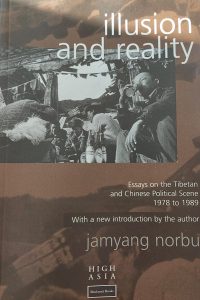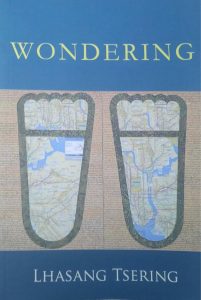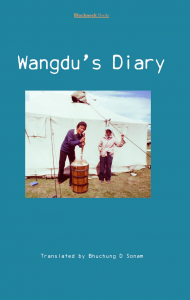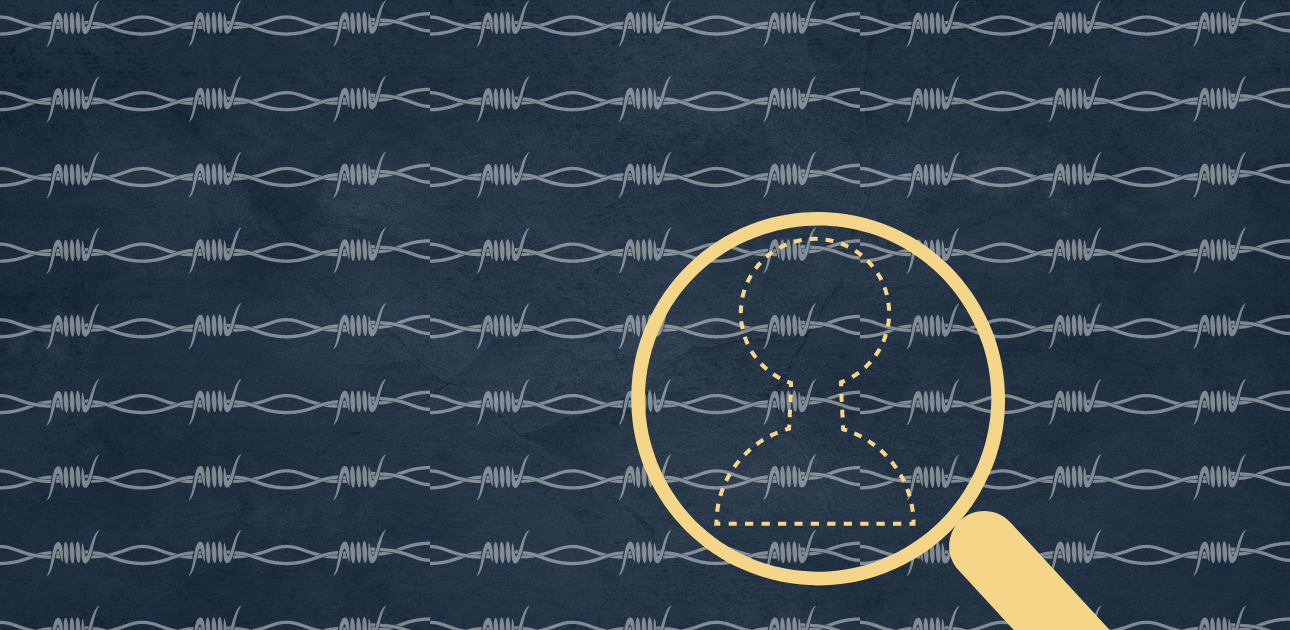Understanding detentions of Tibetans and many others in People’s Republic of China on the United Nations International Day of the Victims of Enforced Disappearances through poems, essays and the written word.
—
“ONE does not establish a dictatorship in order to safeguard a revolution; one makes the revolution in order to establish the dictatorship. The object of persecution is persecution. The object of torture is torture. The object of power is power. Now you begin to understand me.”
― English writer George Orwell, ‘1984’
Dharamshala was not always a sleepy little tourist town, crowned by the hippie village of Dharamkot, and the interstitial suburb – Mcleod Ganj, that hosts the Tibetan refugee community and government in exile.
The People’s Liberation Army of the People’s Republic of China (‘PRC’) began the invasion of Tibet in 1949, when Chinese communist revolutionary Mao Zedong established the PRC and threatened Tibet with ‘liberation’. It was the same year that Orwell’s dystopian novel 1984 was published, as noted by Tibetan political activist and writer Jamyang Norbu in his 1985 essay of the same name – Nineteen Eighty-Four: Surrendering to the Nightmare (published in his book ‘Illusion and Reality: Essays on the Tibetan and Chinese Political Scene 1978 to 1989’).


Tibetans began arriving in India from 1951 onwards, when their nation was overrun by troops from the PRC. Eight years later, the Dalai Lama – the foremost spiritual leader of the Tibetan people – made Mcleod Ganj his seat of spirituality and governance, after escaping from his homeland to India. A fate he shared with his predecessor – the 13th Dalai Lama, who lived in Darjeeling for two years after fleeing from Tibet due to threats from Imperial China.
The People’s Liberation Army of the People’s Republic of China began the invasion of Tibet in 1949, when Chinese communist revolutionary Mao Zedong established the People’s Republic and threatened Tibet with ‘liberation’.
In 2008, Mcleod Ganj was also host to a burgeoning freedom movement that seemingly went against the Dalai Lama’s calls for peace and nonviolence. A coalition of Tibetan exile organizations, called the Tibetan People’s Uprising Movement, struck out on a ‘Return March to Tibet’. The march corresponded with a large-scale and coordinated uprising that erupted in Lhasa, the capital city of the Tibet Autonomous Region of China, in response to the 2008 Summer Olympics held in Beijing.
The protests were condemned and the Indian protestors were arrested in Uttarakhand. Since then, Tibetan dissenters in India have limited their activism to observations of important days, such as the International Day of Justice, and in the realm of language, through poetry, prose and essays. Perhaps, the most extreme form of expressing exasperation has been through self-immolations, conducted by over 150 Tibetan individuals in India, Nepal, and the PRC.
Resistance in PRC-occupied Tibet
After China illegally occupied Tibet, a martial law was imposed to crack down on the Tibetan resistance movement, and political prisoners were detained en masse. Many have not been seen or heard from since their forcible detention.
The 2008 uprising led to a fresh-wave of usage of disproportionate force, arbitrary and secret detentions, and disappearances of protestors and ordinary Tibetans, nuns and thousands of monks. For instance, Yeshi Lhakdron, a 25 year-old Tibetan nun, disappeared after her arbitrary detention by PRC security forces for sloganeering during the 2008 uprising. While two other nuns from the same nunnery, Sangay Lhamo and Tsewang Khando, were released after completing their two-year prison sentences, nothing was heard about the fate of Lhakdron despite her family’s efforts.
The Tibetan Centre for Human Rights and Democracy (‘TCHRD’) reported that at least one thousand Tibetans disappeared, following the uprising. Their whereabouts were unknown to family members and affiliated monasteries at the time. In 2012, at the time the TCHRD report ‘Into Thin Air’ was published, the Chinese government had refused to divulge information on the exact number of arrests and how many Tibetans were sent for extrajudicial forms of detention, such as ‘reeducation through labour’.
The Tibetan Centre for Human Rights and Democracy reported that at least one thousand Tibetans disappeared, following the 2008 uprising.
Many activists were prompted to push back against the PRC’s actions following the uprising. In 2009, Tibetan poet, writer and activist Lhasang Tsering voiced the collective angst of Tibetan exiles in a poem titled Would, found in his 2012 collection of poems called ‘Wondering’, and reproduced below.
“Would
Would that my Homeland –
Was not under foreign occupation;
Would that my nation –
Was not under foreign oppression.
Would that my Faith and Culture –
Were not being abused and suppressed;
Would that my Temple and my home –
Were not desecrated and destroyed.
Would that Tibetans in Tibet –
Were not being imprisoned and tortured;
Would that the people of Tibet –
Were not facing extermination.
Would that my parents –
Were not exiled to a distant land,
Would that I was not –
Not orphaned at an early age.
Would that my country Tibet –
That Tibet was free once more;
Would that I had the Right –
The right to return to Tibet.
Would that I had the Right –
The right to Live in Tibet:
Would that I had the Right –
The right to Die in Tibet.”


Detaining Tibetans in China
Shadows by Tibetan poet Tsering Dolkar:
“The streets of Lhasa have their own shadows
And shadows have their way of living
If you stare long enough you may see them flicker and talk
Stand in line; wait for your turn as if a pilgrim in the early morning
Lean and press your ears to the peephole
Listen to Jokhang’s lost sea and its demonic mistress…
Time is eternal in the dark sea
The waves have swallowed my last shriek
In the madness of my grief I sit, my face upturned
Are you capable of kindness to yourself?
Then look at me!
I am you exiled by fear, chained underneath a blatant lie.
Those who have seen her have never returned
Vanished under broad daylight as if imagination
Flitting in and out, no one knows if they live or die
I hear they join the shadows across the city
It must be true; of late their numbers have increased
I see them hover in groups when prying eyes have gone to sleep.”
(Jokhang, also known as the Jokhang Monastery, is a Buddhist temple in Barkhor Square in Lhasa.)
The PRC’s policy towards Tibetans includes forcible detention of children and their families. The most well-known case is the forcible detention of the spiritual figure Gedhun Choekyi Nyima, who has been missing along with his parents for over 27 years, since he was six years old. Similarly, Tibetans who managed to flee to India, have reported being detained by PRC authorities as children, before their escape, without any communication with their families and others.
A 2021 report by the United States State Department on the PRC’s aggregated ongoing human rights violations of Tibetans by the PRC in Tibet, including torture, arbitrary and secret detentions, disappearances, and violence. It detailed many cases of arbitrary deprivation of life and other unlawful or politically motivated killings. For instance, a Tibetan named Norsang was held incommunicado after his 2019 detention for refusing to participate in PRC’s political reeducation training, and was allegedly tortured to death. Norsang reportedly died while in the custody of local security officials, who only revealed his death a few months later.
It states that police and prison authorities in the PRC have often employed torture and cruel, inhuman, or degrading methods of punishment towards detainees. For instance, Kunchok Jinpa, a political prisoner serving a 21-year sentence, died in a hospital shortly after his release from prison, possibly due to severe brain haemorrhage resulting from the beatings he endured in prison.
The PRC’s policy towards Tibetans includes forcible detention of children and their families.
In some cases, Chinese authorities do not disclose the reason behind detentions, leaving family and friends of detainees in the dark regarding the cause behind their disappearance. For instance, the U.S. State Department report documents that Gen Sonam, a senior manager of the Potala Palace, was detained in 2019, and his whereabouts remained unknown. Often, Tibetans are arbitrarily and secretly detained for petty offenses and slights, like sharing photos of the Dalai Lama or refusing to denounce him, communicating with Tibetans in exile, asserting religious and cultural identity, and showing interest in the Tibetan language.
In fact, PRC’s tactics are not limited to its response to the 2008 uprising. In the personal account of a member of the 1980 Third Fact-finding Delegation to Tibet called ‘Wangdu’s Diary’, published in 2020, the eponymous Wangdu noted that:
“Political prisoners are made to undergo hard labour such as farming, construction, tree-felling and brick-making. They are kept in labour communes even after they have served their prison terms. There are many prisoners who were jailed since 1959 and whose homes have since been demolished or confiscated. There are labour camps in Namring, Emagang in Shigatse, Lhasa (Sangyip, Gutsa, Drapchi), Nyethang, Nakchu, Tsethang, Kongpo (Powo Tramok), Chamdo, Drago and many other places. These prisoners have no freedom whatsoever and the Chinese government exploited them as free labour. When we were in Nakchu, we asked the Chinese officials to allow us to visit Emagang labour camp in Shigatse. However, they responded that the river had swollen due to heavy rains and we were refused permission to go there.” (p. 151)


Struggles of colonialism
Reading about Tibet’s occupation by communist colonizers reminds me of our own centuries-long history with the British. It makes me wonder if future generations will resort to PRC colonial apologism, like the British continue to exercise.
Will Tibetans of a future, free Tibet, suffer from a colonial hangover, as experienced in India? In India, even institutions are not immune, with issues such as that of regularizing posts in the Union Government’s Department of Posts, archaic hierarchies in the Parliament, and the use of lathi-charge by the police, a common weapon employed against Indian freedom fighters by the British. Indian laws continue to suffer from this malaise, primary among them being the British-era laws used to suppress liberties, such as the sedition law under Section 124A of the Indian Penal Code (which was, thankfully, suspended by the Supreme Court earlier this year).
Poems, essays and books that are also records and memory keepers of enforced disappearances, and other human rights violations in China, suggest that their history may be harder to erase and barter for cheap, toxically optimistic remembrances of oppression, as done by other colonial apologists.
For instance, regarding the policy of Chinese appeasement by the Tibetan government in exile, in the essay Nineteen Eighty Four, Norbu noted that:
“The one sensible thing we can do now is acknowledge the fact that we were badly mistaken in our hopeful assessment of the present Chinese leadership. This may seem a matter of course, but sophistry has never been in short supply in Tibetan government circles, especially after failures; and a great deal of intelligence can be invested in ignorance when the need for illusion is deep. But if we can make this admission, and I do not say it will be an easy thing to do, then our defeat bad as it may be, will mark a positive turning point in our struggle against Chinese tyranny. At least we will have no more illusions left about the Chinese and that is a great thing. We might then at least know where we stand and what we must do.”
In a way, the cutting off between Tibetans in Tibet and those in exile, due to heavy travel restrictions, amounts to a kind of forced detention of all Tibetans under PRC’s rules. Now, due to China’s changing policies and increased surveillance, even communication is increasingly impossible.
The cutting off between Tibetans in Tibet and those in exile, due to heavy travel restrictions, amounts to a kind of forced detention of all Tibetans under PRC’s rules. Now, due to China’s changing policies and increased surveillance, even communication is increasingly impossible.
The sentimentalities of separated family members has been captured by Tibetan writer, poet and actor Ten Phun in a poem to his acha (sister) back in Lhasa. An excerpt has been reproduced below:
“No worries Acha
Fitful dream of last night,
Tearful eyes in the morning.
I began rewriting my incomplete poem for you
I will be back soon, Acha.
It might take a year or even two,
Five years at the most,
I will be back.
I don’t belong here,
I just don’t belong here.
I am only a wanderer,
I am a lost soul.
At times I really miss you.
I missed you when
I thought life wasn’t acting so generously with me.
I missed you when I knew that
I was an indifferent boy, who
Fought with the neighbour’s sons.
I missed you when I knew that
I was not reaching my promised land.
I remember sleeping with those letters you sent me from home,
You said you would come to meet me after several years.
It’s been fifteen now,
Fifteen years of my life without seeing you even once.
Do I have to say “No worries”?”
Perhaps, even if literature cannot free Tibet, it performs the important function of accurately recording the insidiousness of occupation: something that Tibetans in Chinese-occupied Tibet cannot do at all, for fear of incarceration, disappearances and worse.
Enforced disappearances continue beyond Tibet
The use of enforced disappearances of ethnic groups in the PRC is not limited to the Tibetans. Uyghurs and Muslim ethnic minorities have been subjected to arbitrary detention, torture, egregious restrictions on religious practice and culture, and a digitized surveillance system in the Xinjiang Uyghur Autonomous Region. As many as a million people may have been detained in PRC’s “political reeducation” centers, in what is called the largest mass incarceration of an ethnic minority population in the world today.
Even if literature cannot free Tibet, it performs the important function of accurately recording the insidiousness of occupation: something that Tibetans in Chinese-occupied Tibet cannot do at all, for fear of incarceration, disappearances and worse.
According to international non-governmental organization Human Rights Watch, prominent Uyghurs who disappeared in the PRC’s “Strike Hard Campaign against Violent Terrorism” include academic Rahile Dawut, though her alleged offense, sentence, and location of imprisonment remained unknown. There were also reports of Uyghurs dying in detention, including biotech researcher Mihriay Erkin, businessman Yaqub Haji, and poet and publisher Haji Mirzahid Kerimi.
Also read: ‘Pakistan using Kashmiris as pawns against India’: Exiled Uyghur rights’ activist Halmurrat Harri
Chinese human rights defenders and lawyers also face the brunt of secret detentions. For instance, three supporters of human rights disappeared from Xiamen city, after being arrested in December 2019 for attending an informal weekend gathering on the situation of civil society and politics in China. Ding Jiaxi, Zhang Zhongshun and Dai Zhenya, have been held by PRC authorities in a form of detention called Residential Surveillance in a Designated Location (‘RSDL’). One of the most famous instances of this includes Chinese artist Ai Weiwei’s 81-day secret detention in 2011 in Beijing.
RSDL has been legalized under Article 75 of the Criminal Procedure Law of the PRC. It allows the Public Security Bureau to detain a person under RSDL, for as long as six months, in an undisclosed location kept secret from even family members and lawyers of the detainees.
RSDL has long been identified as a form of incommunicado detention.
United Nations and RSDL
On December 21, 2010, the United Nations (‘UN’) General Assembly welcomed the adoption of the International Convention for the Protection of All Persons from Enforced Disappearance, and declared August 30 as the International Day of the Victims of Enforced Disappearances.
Enforced disappearance is used as a strategy to spread terror, impacting not just victims but also close relatives of the disappeared, their communities and society as a whole.
Enforced disappearance is used as a strategy to spread terror, impacting not just victims but also close relatives of the disappeared, their communities and society as a whole. Globally, it has been used by military dictatorships, in complex situations of internal conflict, as a means of political repression of opponents, to harass human rights defenders, relatives of victims, witnesses and legal counsel. It is used with impunity by States, often under the guise of counter-terrorist activities.
UN General Assembly Resolution 68/156, adopted on December 18, 2013, established that “prolonged incommunicado detention can facilitate the perpetration of torture and other cruel, inhuman or degrading treatment or punishment and can in itself constitute a form of such treatment, and urges all States to respect the safeguards concerning the liberty, security and dignity of the person.”
While reviewing the PRC’s fifth periodic report to the UN Committee Against Torture in November 2015, the Committee expressed concern that under RSDL stipulations, although families are required to be notified within 24 hours of the decision, they are not required to be told the reason or the place of detention, possibly an unregulated and unmonitored facility.
Further, the law allows for refusal of access to a lawyer. Thus, it may amount to incommunicado detention in secret places, putting detainees at a high risk of torture or ill-treatment. In its Concluding Observations, the Committee stated:
“The State party should repeal, as a matter of urgency, the provisions of the Criminal Procedure Law that allow suspects to be held de facto incommunicado in residential surveillance at a designated location. In the meantime, the State party must ensure that procuratorates promptly review all the decisions of residential surveillance taken by public security officers, ensure that detainees who are designated for potential prosecution are charged and tried as soon as possible, and those who are not to be charged or tried are immediately released. If detention is justified, detainees should be formally accounted for and held in officially recognised places of detention. Officials responsible for abuses of detainees should be held criminally accountable.”
Protestors in Hong Kong met a similar fate. The Committee expressed concern over consistent reports of mass detentions of people in the context of demonstrations and the alleged restrictions to the detainees’ legal safeguards. For instance, as per the Committee, 511 persons were arrested in connection with an assembly that followed the annual Hong-Kong march on July 1, 2014, and only 39 lawyers met with the arrestees during their detention.
Earlier this year, owing to these unlawful and egregious practices by the PRC, a group of UN human rights experts urged the Chinese government to cooperate and grant unhindered access to independent experts, including: “allowing visits by UN Special Procedures mechanisms and granting full access, particularly to places of detention.”
Evidently, PRC will not easily give up the use of terrorizing tactics like illegal and secret detentions and enforced disappearances that were first tested on Tibetans, which now also include undiplomatic interference with democracies over affairs related to Tibetans, and broad human rights violations.
Also read: Resolution of India – China Border Dispute over Ladakh is the need of the hour
It is not just Lhasang Tsering, who is left wondering:
“Which is the best way?
What is the best solution?”
(Excerpt from the poem Why? (2009))


